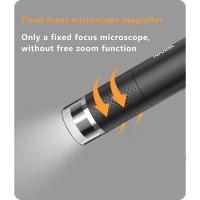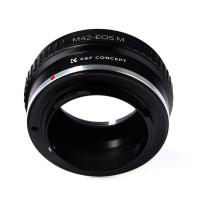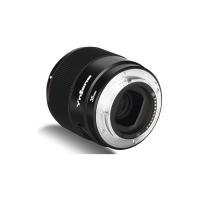What Are The Parts Of A Light Microscope ?
The main parts of a light microscope include the eyepiece, objective lenses, stage, condenser, diaphragm, light source, and focus knobs.
1、 Eyepiece
The parts of a light microscope include the eyepiece, also known as the ocular lens, which is the lens closest to the eye. The eyepiece typically magnifies the image produced by the objective lens. It is usually a combination of lenses that further magnify the specimen and allow the viewer to see a larger image.
In addition to the eyepiece, a light microscope consists of several other essential components. The objective lens is the primary lens responsible for magnifying the specimen. It is located near the specimen and can be interchanged with lenses of different magnification powers to achieve various levels of magnification.
The stage is the platform where the specimen is placed for observation. It often includes clips or a mechanical stage to hold the specimen in place and allow for precise movement. The condenser is a lens system located beneath the stage that focuses and directs light onto the specimen, enhancing the clarity and brightness of the image.
The light source, typically an adjustable lamp, provides illumination for the specimen. It can be positioned above or below the stage, depending on the microscope design. Some modern microscopes may use LED lights for improved energy efficiency and longevity.
The focus knobs, consisting of coarse and fine adjustment knobs, allow the viewer to bring the specimen into sharp focus. The coarse adjustment knob is used for initial focusing, while the fine adjustment knob is used for precise focusing.
Lastly, the body tube or head houses the optical components of the microscope and connects the eyepiece to the objective lens. It often contains a prism or mirror to redirect the light from the objective lens to the eyepiece.
It is important to note that advancements in technology have led to the development of more sophisticated microscopes, such as confocal microscopes and electron microscopes, which offer higher magnification and resolution capabilities. These advanced microscopes may have additional components and features to enhance imaging and analysis.
2、 Objective lenses
The parts of a light microscope include the objective lenses, which are one of the most crucial components of the instrument. Objective lenses are responsible for magnifying the specimen being observed and are located at the lower end of the microscope's body tube. They are typically available in various magnification powers, such as 4x, 10x, 40x, and 100x.
Objective lenses are designed to gather light from the specimen and focus it to produce a magnified image. They consist of multiple glass elements that work together to minimize aberrations and improve image quality. The quality of the objective lenses greatly affects the resolution and clarity of the observed specimen.
In recent years, there have been advancements in objective lens technology. One notable development is the introduction of high numerical aperture (NA) lenses. NA is a measure of the lens's ability to gather light and resolve fine details. High NA lenses allow for improved resolution and the observation of smaller structures within the specimen. These lenses are particularly useful in fields such as cell biology and microbiology, where the ability to visualize intricate details is crucial.
Additionally, some modern microscopes now incorporate motorized objective lenses, which can be controlled remotely. This feature allows for easy switching between different magnification powers without physically changing the lenses. It also enables automated imaging and data collection, making the microscope more efficient and user-friendly.
In conclusion, objective lenses are an essential part of a light microscope, responsible for magnifying the specimen and producing a clear image. Recent advancements in objective lens technology, such as high NA lenses and motorized lenses, have further improved the capabilities and functionality of light microscopes.
3、 Stage
The parts of a light microscope include the stage, which is a flat platform where the specimen is placed for observation. The stage typically has clips or a mechanical stage to hold the specimen in place. It also often includes a stage control knob to move the stage horizontally or vertically, allowing for precise positioning of the specimen under the objective lens.
In addition to the stage, a light microscope consists of several other essential components. These include the eyepiece or ocular lens, which is the lens closest to the viewer's eye and typically provides a magnification of 10x. The objective lenses, located on a rotating nosepiece, are responsible for magnifying the specimen. Common objective lens magnifications include 4x, 10x, 40x, and 100x.
The condenser is another important part of a light microscope. It is located beneath the stage and helps focus the light onto the specimen. The diaphragm, which is usually located within the condenser, controls the amount of light passing through the specimen.
Modern light microscopes often include additional features such as a built-in light source, typically an LED, which provides illumination for the specimen. Some microscopes also have a focus adjustment knob, allowing for fine-tuning of the focus.
It is worth noting that advancements in technology have led to the development of more sophisticated light microscopes, such as confocal microscopes and fluorescence microscopes. These microscopes incorporate additional components and techniques to enhance imaging capabilities, such as laser illumination and specialized filters.
Overall, the stage is just one of the many important parts of a light microscope, working in conjunction with other components to enable the observation and analysis of microscopic specimens.
4、 Condenser
The parts of a light microscope include the condenser, which is an essential component responsible for focusing and directing light onto the specimen being observed. The condenser is typically located beneath the stage and consists of a lens system that collects and concentrates light from the light source, such as a bulb or LED.
The main function of the condenser is to increase the intensity and uniformity of the light that passes through the specimen. It achieves this by focusing the light into a narrow beam and directing it through the specimen and into the objective lens. The condenser also helps to control the contrast and resolution of the image by adjusting the aperture size, which determines the amount of light that reaches the specimen.
In recent years, there have been advancements in condenser technology to improve the performance of light microscopes. One such advancement is the development of adjustable condensers, which allow users to control the angle and position of the condenser to optimize the illumination for different types of specimens. This flexibility enables researchers to achieve better contrast and resolution, particularly when observing specimens with varying thickness or transparency.
Additionally, some modern light microscopes now incorporate specialized condensers, such as phase contrast or darkfield condensers. These condensers utilize different optical techniques to enhance the visibility of specific types of specimens, such as transparent or unstained samples.
Overall, the condenser plays a crucial role in the functioning of a light microscope by providing the necessary illumination and control to produce clear and detailed images of the specimen under observation.






































